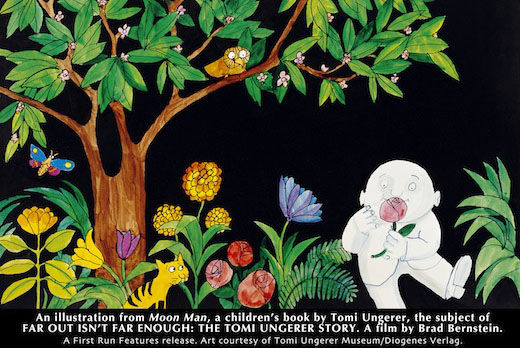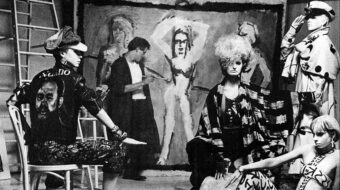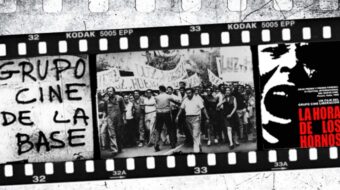
Contrast, courage, and challenge … these are the words one may think of when viewing “Far Out Isn’t Enough: The Tomi Ungerer Story,” written, produced, and directed by Brad Bernstein. Some may be familiar with Ungerer’s award winning children’s books, but perhaps less so his subsequent and controversial antiwar posters and adult erotica. The themes of contrast, courage and challenge are prevalent throughout the 98-minute film and the artist himself touches upon them numerous times. The documentary, which gives Ungerer carte blanche to express his ideas, premieres on screens this summer.
Tomi Ungerer was born November 28, 1931, in Strasbourg, France, of German heritage. In the film, he reflects back to the outbreak of World War II. His family attempted to keep their French identity, but the French language was forbidden during the Nazi occupation of Alsace. Fear was prevalent, and the young boy experienced much of it. Life never returned to normal for the youngster after the war, as his heavy German accent (which is still very pronounced as he speaks in this film) created some prejudice against him. He arrived in New York City in 1956, and began writing and illustrating children’s books. It was in his work he confronted the concepts of fear and courage, stemming from his memories of fascist occupation.
Tomi Ungerer’s artistic design went far beyond children’s books. He drew illustrations for such publications as the Village Voice, which led to more ambitious adult/erotic collections. A trip to the American South in the early 1960s shocked him as he experienced his first taste of racism through segregation. His outrage led to the creation of the 1964 anti-racist book, “Underground Sketchbook.” He followed up in 1966 with “The Party,“ a parody of elitist society he observed in Manhattan. By this time, the Vietnam War was full force. The atrocities from that war brought back memories of his youth under German occupation. This led to his designing extreme and poignant anti-Vietnam-War posters. Viewers of this film who are unfamiliar with Ungerer’s posters will be startled at the strong and harsh imagery that is shown. They really pack a punch, as reiterated by the artist during his commentary.
The film presents much archival footage of a youthful Ungerer exploring the Manhattan of the 1950s and ’60’s. There are praises from contemporaries Jules Feiffer and Maurice Sendak, who says that inspiration for his classic, “Where The Wild Things Are,” came from Ungerer’s earlier works. Both fellow illustrators make it clear they had no aversions to Ungerer’s “adult” art. Viewers also get some insight into his family life, with on-screen comments from his daughter, who says her father has always searched for an identity. From his heritage to his art, he defines contrast.
In 1969, the artist reached the zenith of his work in “adult” illustration with “Fornicon: The Erotic Art of Tomi Ungerer.“ He was still very active in writing children’s books. Ungerer had no problem traversing both worlds of art, and managed to keep them separate. Unfortunately, libraries across America were not as understanding, and his popular works were removed from library shelves. This took a toll on the artist, and he retreated to a small town in Nova Scotia during the mid-1970s.
Reflecting on this period in his life, Ungerer explores the frustration of an artist paying the price for pushing the limits of his abilities. He describes how ideas kept snowballing into his mind without effort. He says every challenge should immediately be followed with another greater challenge, which leads to the title of the film: “Far Out Isn’t Far Enough.” Unsure of an afterlife, he welcomes the prospect of nothingness as the greatest challenge. Even in finality, the spirit of the artist shines through.
Nowadays, Ungerer splits his time between Ireland and Strasbourg. Images from his hometowns are interspersed with commentary and colorful animated sequences in his current work. It’s an equal treat for mind and eye.
His children’s books have steadily resurfaced through the decades, and are once again welcomed in American libraries. In 1998, he received the Hans Christian Andersen Award For Illustration. He seems genuinely happy to once again be acknowledged for that work, as witnessed by the emotion he shows on screen. Still an activist, he has worked hard to support the European Union, especially between France and Germany.
This film will keep audiences engaged throughout, and will be a unique inspiration to artists who often see their creative processes making extreme, sharp turns … sometimes at a great cost to the individual.
See the movie website for screening locations and dates.
Movie information:
“Far Out Isn’t Enough: The Tomi Ungerer Story“
Written, produced and directed by Brad Bernstein
2012, 98 min.












Comments